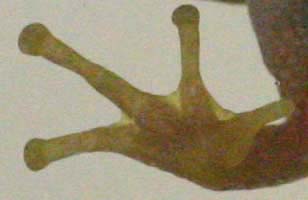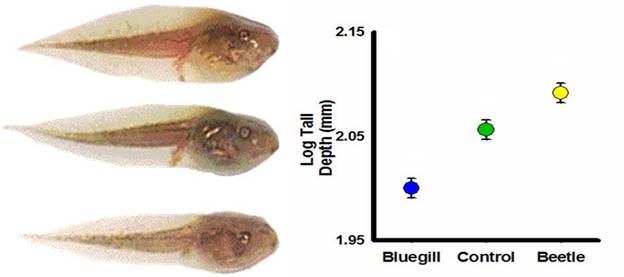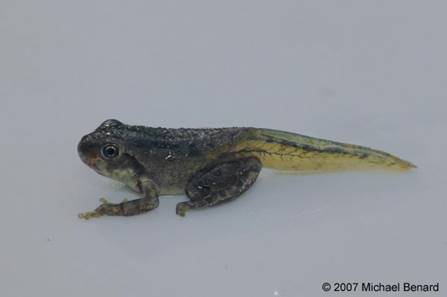the frogs are croaking in the swams and marhes; their notes do not differ from those of the Atlantic States; they are not found in the salt marshes near the entrance of the river. Merriweather Lewis, March 29, 1806. Near Deer Island (likely Sauvie Island), along the Columbia River.
Also referred to as the Pacific tree frog, these small amphibians are a common occurrence in PNW forests, swamps, ditches, and even large puddles. They range along the west coast of the US from northern California, through Oregon and Washington, and into British Columbia and southern Alaska. They can be found from sea level up to elevations of 10,000 feet. They are the most common amphibian along the west coast.
Pseudacris – Greek, pseudes – false, deceptive and akris – locust (false locust); and regilla – Latin, regal or splendid, referring to the colors.

Pacific chorus frog color can change from bright green to a dull brown in as short of time as a few hours. They have a white belly and a dark eye stripe that stretches from the nose to the back of the shoulder. They grow to a maximum of 2 inches and the males are generally smaller than the females. Males have a noticeable throat sac that is used when singing. They have small bumps on the skin. The skin can change color to better match the environment, while some color differences have a genetic basis. The toes are only slightly webbed but have a sticky toe pad at the end that facilitates climbing.

These small frogs begin mating in early winter to early spring. The call of the male sounds like a creaky door opening and closing and in the winter, like a very-slowly-opening-door. It sounds something like “rurrkk-uk, rurrkk-uk, rurrkk-uk” or “ Kreck-ek”. You choose. Calling
During these breeding choruses, males sit near the water’s edge, and use different types of vocalizations to communicate with other males and females. Many people are familiar with the Pacific chorus frog’s ‘advertisement’ call, which consists of a two-part ‘Kreek-eeck’ sound. The primary function of the advertisement call is to attract mates. Mate selection is not a random process; female Pacific chorus frogs prefer to mate with males that make advertisement calls more frequently than the other males
Eggs take several days to hatch and the young tadpoles are potential meals for a wide range of predators including insects, birds, garter snakes, raccoons, and fish, among others.
The tadpoles feed on periphyton, filamentous algae, and diatoms, and sometimes on pollen on the water surface. Because they often lay eggs in ephemeral pools they are at risk of desiccation if the pool dries up before they metamorphose into a small froglet. Interestingly, tadpoles that detect their pond is drying up will accelerate their change into an adult form. I’ve seen them in large puddles in the potholes on dirt roads.
Some research in California indicates that chorus frog tadpoles will respond morphologically when predators are common in their rearing water. In the presence of predatory insects, tadpoles develop deep tails (top tadpole). In the presence of predatory fish, tadpoles have shallow tails (bottom tadpole). Tadpoles that are not exposed to cues from predators are intermediate in shape.

As adults they are mostly nocturnal and spend a lot of time under rotten logs, rocks, and organic debris during the day. Their diet consists of spiders, beetles, flies, ants, and other insects and arthropods. When they sense a prey item they will commonly twitch a toe to attract it nearby and in reach of their tongue.

Because they are so common in California they often are heard in movies that are set outside of their range. This would not be a big deal for the non-herpetologically aware, but, as you can guess, someone is keeping track of this mis-casting. There is a growing database of movies where Pacific chorus frogs are heard in the background – but really shouldn’t be there. I think the Netflix Marco Polo series is my favorite – they don’t live along the Silk Road: Lost Frogs
There have been some reports of chorus frogs being transported out of the northwest and into areas they do not occupy, hitchhiking on Christmas trees. In one documented case an individual made it all the way to Guam. And in case you need a new coffee mug: Frog Mug
had been conducting some fieldwork years ago in the foothills of the Washington Cascades and we parked on a dead-end road to spend the day in the forest. We saw the almost-transformed tadpoles in the roadside ditch but took little notice beyond that. It was a warm day and when we got back to the car the parking area and road was just filled with froglets. En masse they decided this was the day they were going terrestrial. There were literally hundreds of the tiny frogs littering the dirt road. We spent the better part of an hour picking them up and moving them into the forest so we wouldn’t run over them. We kept the carnage to a minimum and went on our way.
